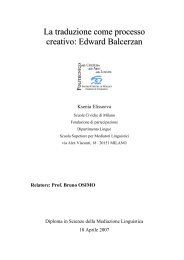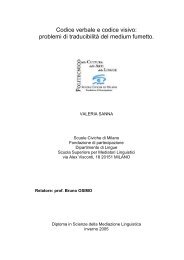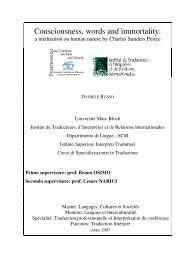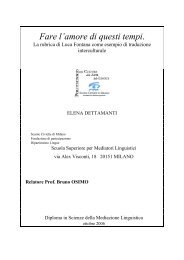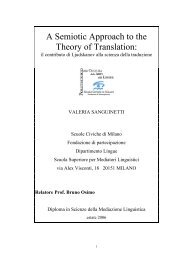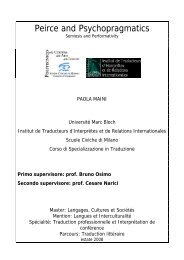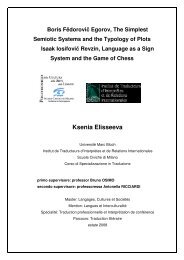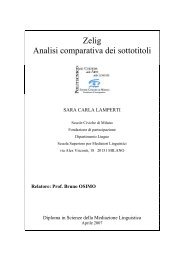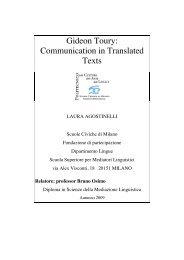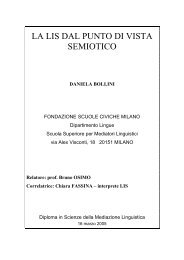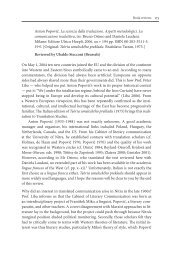Alice in Wonderland - Bruno Osimo, traduzioni, semiotica della ...
Alice in Wonderland - Bruno Osimo, traduzioni, semiotica della ...
Alice in Wonderland - Bruno Osimo, traduzioni, semiotica della ...
You also want an ePaper? Increase the reach of your titles
YUMPU automatically turns print PDFs into web optimized ePapers that Google loves.
whereas Hugo may be identified as a German. In order to avoid the<br />
impression that this is a bicultural sett<strong>in</strong>g, the translator would have to<br />
either substitute Miguelito by a clearly German name or replace Hugo by a<br />
typical Spanish name, depend<strong>in</strong>g on whether the text is <strong>in</strong>tended to appeal<br />
to the audience as “exotic” or “familiar.”<br />
This is a very common problem <strong>in</strong> the translation of children’s books,<br />
especially if there is a pedagogical message underly<strong>in</strong>g the plot. A story set<br />
<strong>in</strong> the receiver’s own cultural world allows for identification, whereas a story<br />
set <strong>in</strong> a strange, possibly exotic world may <strong>in</strong>duce the reader to stay “at a<br />
distance.” This can be clearly shown by an analysis of the Brazilian<br />
translation of <strong>Alice</strong> <strong>in</strong> <strong>Wonderland</strong>, where all the culture markers, <strong>in</strong>clud<strong>in</strong>g<br />
the proper names, are consistently adapted to the target culture (cf. Nord<br />
1994).<br />
Different name conventions <strong>in</strong> literature can also lead to translation<br />
problems. If, as stated above, names are adapted to the Spanish language<br />
and culture <strong>in</strong> Spanish literature and, on the contrary, serve as culture-<br />
markers <strong>in</strong> German literature, the translator should take this <strong>in</strong>to account.<br />
In a Spanish play set <strong>in</strong> France (Max Aub, El puerto), the characters are<br />
called Claudio, señora Bernard, Josef<strong>in</strong>a, Andrés, Marcela, Julio and Matilde<br />
(all of them French) and Estanislao Gar<strong>in</strong> Bolchenko (Polish) <strong>in</strong> the orig<strong>in</strong>al.<br />
In the German translation (Max Aub, Der Hafen), all the French characters<br />
have French names (Claude, Madame Bernard, Joséph<strong>in</strong>e, André, Marcelle,<br />
Jules, Mathilde) and the Pole is called Stanislas Gar<strong>in</strong> Bolschenko (<strong>in</strong><br />
German transcription).<br />
In the follow<strong>in</strong>g section, we will apply these considerations to the<br />
translation of proper names <strong>in</strong> <strong>Alice</strong> <strong>in</strong> <strong>Wonderland</strong>. We will first look at the<br />
forms and functions of the proper names appear<strong>in</strong>g <strong>in</strong> the book and then<br />
discuss the translation procedures found <strong>in</strong> the various translations which<br />
constitute our corpus and their possible effects for the reception of the book.<br />
Thus, our approach is both functional and descriptive.<br />
35



